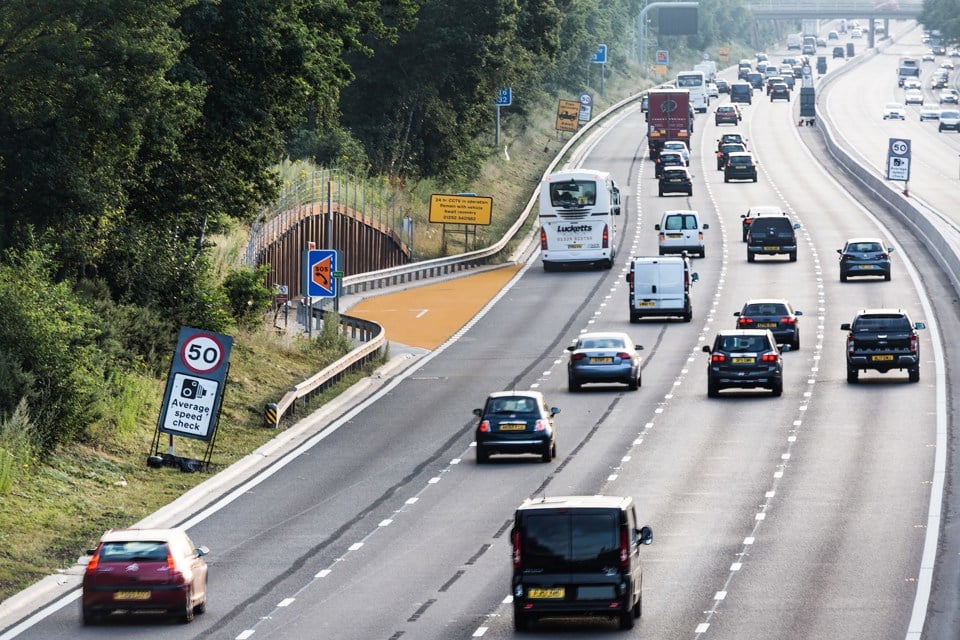National Highways has defended the safety record of so-called smart motorways after claims technology supposed to keep drivers safe fails regularly.
Figures obtained by Panorama revealed hundreds of incidents when crucial safety equipment was out of action, leaving vehicles stranded in fast-flowing traffic.
Furthermore, a traffic officer who works on the network told the programme he no longer considers smart motorways safe.
National Highways, however, says “smart motorways are our safest roads”.
The Government agency maintains major routes in England, including smart motorways which are stretches of road where technology is used to regulate traffic flow and ease congestion.
These include 193 miles of “all-lane-running" motorways where the hard shoulder has been permanently removed to provide an extra lane.
A further 63 miles of smart motorway sometimes opens the hard shoulder to traffic, while there are a further 140 miles of the network where the hard shoulder has been retained.
Operational control director at National Highways, Andrew Page-Dove, said: “Safety is our highest priority and our motorways are statistically some of the safest in the world, but there is still work to do as every death is a tragedy and every serious injury a life changed.
“We need to help everyone feel confident when using smart motorways.”
The move to smart motorways began in the Midlands on the M42 in 2006, but new smart motorways – including 11 that had already been paused and three new schemes – were halted by the Government in April 2023, with ministers citing financial pressures and a lack of public confidence.
Seven of the 14 projects were going to involve converting stretches of motorway into all-lane running roads. They will now remain as ‘dynamic’ smart motorways where the hard shoulder can be opened as an extra lane during busy times.
However, figures released following a Freedom of Information (FOI) request show that between June 2022 and February 2024 there were 392 incidents when motorway technology lost power, making it difficult to detect when a vehicle has broken down.
Outages in some cases lasted for days. For example, for five days in July 2023 there were no signs, signals, camera or radar at junction 18 on the M6.
Meanwhile, in September 2023, there were no signs, signals or CCTV for five days at junction 22 of the M62.
The worst problems were in the latest period covered by the FOI figures. In the six months leading up to February 2024, there were 174 power outages - almost one a day.
Problems with the technology used on smart motorways to identify stopped vehicles in live lanes were flagged by the Office of Rail and Road (ORR) in a safety report published in December 2022.
The ORR report said the performance of stopped vehicle detection, which is the radar-based technology on every all lane running smart motorway where the hard shoulder has been permanently converted to a live traffic lane, was falling short of the performance requirements the company set itself.
A further software failure was highlighted in February 2023, when an outage froze signs and signals, and deactivated the stopped vehicle detection system for two hours.
The fault, which occurred on the M5, M6, M62 and M60 as well as the M1 north of Northampton, meant National Highways was unable to change signals in overhead gantries to close lanes with a red 'X' sign where a hazard had been detected.
However, National Highways argues that reinstating hard shoulders could put more drivers and passengers at risk of death and serious injury.
It would also remove vital road capacity; congestion would increase significantly with the potential consequence of drivers choosing less safe roads away from the motorway network.
It claims that the hard shoulder is perceived to be a place of safety but, in reality, one in 20 motorway fatalities occur there. Emergency areas are safer than hard shoulders, it says.
Emergency areas have orange surfacing, are set back from live traffic lanes and have an emergency phone which connects directly to National Highways regional control rooms, so help can be arranged.
Based on the latest safety data, there have been no deaths in emergency areas, it added.
Page-Dove explained that smart motorways were introduced to provide extra capacity on some of the country’s busiest and most congested sections of motorway.
“The latest data shows that, overall, in terms of serious or fatal casualties, smart motorways are our safest roads,” he said.
“We are taking action to close the gap between how drivers feel and what the safety statistics show by increasing the number of emergency areas, delivering education campaigns, and improving the resilience of our operational technology systems.”
Kira Summers, a senior lecturer in computing and digital technology at Birmingham City University, is calling for an urgent review into the technology and equipment used on smart motorways.
“The recurring failures of technology supporting England's smart motorway network, supported by National Highways’ data, indicate a significant risk to life and safety for drivers and highways workers,” she said.
“With hundreds of instances in which crucial safety equipment has malfunctioned, including radar and cameras, as well as a seeming lack of effective processes and fail-safes, there is clear evidence suggesting systemic issues with the technology that runs smart motorways.
“It is vital that an impartial review is undertaken without delay and before the smart motorway rollout is re-started, in order to determine what these systemic issues are and how best to fix them, which will protect the lives of those who use our roads.”






















NigelBoyle - 24/04/2024 11:04
There is, in effect a hard shoulder as no one in driving in the left lane. They know the dangers!